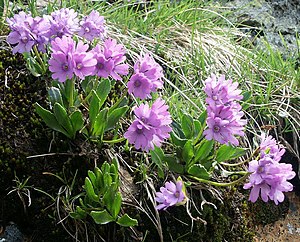Sticky primrose
| Sticky primrose | ||||||||||||
|---|---|---|---|---|---|---|---|---|---|---|---|---|

Sticky primrose ( Primula glutinosa ) |
||||||||||||
| Systematics | ||||||||||||
|
||||||||||||
| Scientific name | ||||||||||||
| Primula glutinosa | ||||||||||||
| Wulfen |
The sticky primrose ( Primula glutinosa ) is a species of plant that belongs to the genus of primroses ( Primula ). Other common names are Blauer Speik and Roter Speik .
description

in Anton Hartinger , Atlas der Alpenflora (1882)
The perennial herbaceous plant reaches heights of 2 to 10 centimeters. It often grows like a lawn and is apparently bare, but has numerous sticky, short glandular hairs on the leaves. The basal leaves are about 6 inches long and finely serrated in front.
The fragrant flowers sit in a little-flowered, capiform, dold-like inflorescence . The broad, egg-shaped, about 7 to 11 millimeters long bracts are reddish brown, as are the often shorter calyxes . The crown has a diameter of about 15 millimeters, is red-violet to dark blue and has a darker ring on the throat. The coronet has deeply edged corolla lobes.
The flowering period extends from June to August.
The number of chromosomes is 2n = 66.
Occurrence
The sticky primrose prefers moist rock debris, willow trellises and crooked sedge and occurs on soils poor in lime at altitudes of 3000 m. The sticky primrose needs acidic, long snow-covered, shallow, humus subsoil. Your secretion is deposited by tiny hairs that are barely visible even with a magnifying glass.
It inhabits lime-poor, dormant debris and gaps in alpine lawns over lime-poor or lime-free rock. It is a character species of the Primulae-Caricetum curvulae from the association Caricion curvulae.
Since their place of growth remains covered by snow for a long time, it flowers quite late, namely from June to August.
The distribution area extends from the Lower Engadine to Styria . Widespread in Austria from subalpine to alpine in the federal states of Styria, Carinthia, Salzburg, Tyrol and Vorarlberg. Scattered in the Central Alps, rare in the Carnic Alps. It is rare in Central Europe; it occurs in the central Alps between Vorarlberg, Graubünden, Carinthia and Styria. Occasionally it rises up to about 3000 m. It is a typical Eastern Alpine plant.
Others
The so-called “ Speik soils ” of the Tyrolean Alps refer to this primrose and not to the real Speik ( Valeriana celtica ).
The sticky primrose can create fertile hybrids in places where silicate and lime meet. The result is called Primula pubescens .
literature
- Xaver Finkenzeller: Alpenblumen , Munich 2003, ISBN 3-576-11482-3
- Wolfgang Adler, Karl Oswald, Raimund Fischer: Excursion flora of Austria. Ed .: Manfred A. Fischer . Ulmer, Stuttgart / Vienna 1994, ISBN 3-8001-3461-6 .
- Dietmar Aichele, Heinz-Werner Schwegler: The flowering plants of Central Europe , Franckh-Kosmos-Verlag, 2nd revised edition 1994, 2000, Volume 3, ISBN 3 440-08048-X
Individual evidence
- ↑ a b Erich Oberdorfer : Plant-sociological excursion flora for Germany and neighboring areas . With the collaboration of Angelika Schwabe and Theo Müller. 8th, heavily revised and expanded edition. Eugen Ulmer, Stuttgart (Hohenheim) 2001, ISBN 3-8001-3131-5 , pp. 738 .
Web links
- Primula glutinosa Wulf .. In: FloraWeb.de.
- Primula glutinosa Jacq. In: Info Flora , the national data and information center for Swiss flora . Retrieved January 16, 2016.